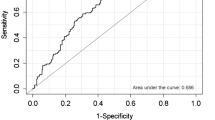Abstract
Background
The National Institute for Clinical Excellence (NICE) is a United Kingdom nondepartmental public body accountable to the Department of Health. Before the introduction of the NICE guidelines in the United Kingdom most children younger than 1 year of age had a urinary tract ultrasound, cyclic micturating cystourethrogram and dimercaptosuccinic acid scintigraphy, the latter delayed 6 months post infection. Children older than 1 year had a urinary tract ultrasound only, and further imaging if necessary.
Objective
Identify who would have been investigated had the NICE imaging strategy been used and who would not. Compare the diagnostic yield and patient outcome with the previous imaging protocol using our prospectively collected historical data.
Materials and methods
We applied the new imaging strategy to a historic cohort of 934 patients with a urinary tract infection (UTI) referred by general practitioners to a specialist children’s hospital between 1996 and 2002.
Results
Of the 934 patients referred, 218 would have been investigated according to the NICE guidelines. In total, there were 105 patients with abnormal imaging findings, and 44 of these (42%) would have been investigated under the NICE guidelines.
Conclusion
Applying the NICE guidelines to children presenting with UTI will reduce the number imaged by 77% and will lead to missed identification of 58% of imaging abnormalities in the group. The majority of these abnormalities may be important. While supporting conservative investigation protocols, we are concerned that many abnormalities might go undetected.




Similar content being viewed by others
References
National Institute for Health and Clinical Excellence (2007) Urinary tract infection in children: diagnosis, treatment and long-term management. http://www.nice.org.uk/nicemedia/pdf/CG54fullguideline.pdf
Royal College of Physicians (1991) Guidelines for the management of acute urinary tract infection in childhood. Report of a working group of the research unit, Royal College of Physicians. J R Coll Physicians Lond 25:36–42
American Academy of Paediatrics. Committee on Quality Improvement, Subcommittee on Urinary Tract Infection (1999) Practice Parameter: the diagnosis, treatment and evaluation of the initial urinary tract infection in febrile infants and young children. Pediatrics 103:843–852
Conway PH, Cnaan A, Zaoutis T et al (2007) Recurrent urinary tract infections in children: risk factors and association with prophylactic antimicrobials. JAMA 298:179–186
Marcus N, Ashkenazi S, Yaari A et al (2005) Non-Escherichia coli versus Escherichia coli community-acquired urinary tract infections in children hospitalized in a tertiary centre: relative frequency, risk factors, anti-microbial resistance and outcome. Pediatr Infect Dis J 24:581–585
Marks SD, Gordon I, Tullus K (2008) Imaging in childhood urinary tract infections: time to reduce investigations. Pediatr Nephrol 23:9–17
Saadeh SA, Mattoo TK (2011) Managing urinary tract infections. Pediatr Nephrol 26:1967–1976
Bouissou F, Munzer C, Decramer S et al (2008) Prospective, randomized trial comparing short and long intravenous antibiotic treatment of acute pyelonephritis in children: dimercaptosuccinic acid scintigraphic evaluation at 9 months. Pediatrics 121:e553–560
Peters CA, Skoog SJ, Arant BS Jr et al (2010) Summary of the AUA guideline on management of primary vesicoureteral reflux in children. J Urol 184:1134–1144
Shaikh N, Ewing AL, Bhatnagar S et al (2010) Risk of renal scarring in children with a first urinary tract infection: a systematic review. Pediatrics 126:1084–1091
Riccabona M, Fotter R (2004) Urinary tract infection in infants and children: an update with special regard to the changing role of reflux. Eur Radiol 4:L78–88
Wheeler D, Vimalachandra D, Hodson EM et al (2003) Antibiotics and surgery for vesicoureteric reflux: a meta-analysis of randomised controlled trials. Arch Dis Child 88:688–694
Pennesi M, Travan L, Peratoner L et al (2008) Is antibiotic prophylaxis in children with vesicoureteral reflux effective in preventing pyelonephritis and renal scars? A randomized, controlled trial. Pediatrics 121:e1489–1494
Schwab CW Jr, Wu HY, Selman H et al (2002) Spontaneous resolution of vesico-ureteric reflux: a 15 year perspective. J Urol 168:2594–2599
Nagler EV, Williams G, Hodson EM et al (2011) Interventions for primary vesicoureteric reflux. Cochrane Database Syst Rev 15, CD001532
De Palma D, Manzoni G (2013) Different imging strategies in febrile urinary tract infection in childhood. What, when, why? Pediatr Radiol 43:436–443
Riccabona M, Avni FE, Blickman JG et al (2008) Imaging recommendations in paediatric uroradiology: minutes of the ESPR workgroup session on urinary tract infection, fetal hydronephrosis, urinary tract ultrasonography and voiding cystourethrography, Barcelona, Spain, June 2007. Pediatr Radiol 38:138–145
Tsai JD, Huang CT, Lin PY et al (2012) Screening high-grade vesicoureteral reflux in young infants with a febrile urinary tract infection. Pediatr Nephrol 27:955–963
Subcommittee on Urinary Tract Infection, Steering Committee on Quality Improvement and Management, Roberts KB (2011) Urinary tract infection: clinical practice guideline for the diagnosis and management of the initial UTI in febrile infants and children 2 to 24 months. Pediatrics 128:595–610
La Scola C, De Mutiis C, Hewitt IK et al (2013) Different guidelines for imaging after first UTI in febrile infants: yield, cost, and radiation. Pediatrics 131:e665–671
Smith EA (2008) Pyelonephritis, renal scarring, and reflux nephropathy: a pediatric urologist’s perspective. Pediatr Radiol 38:S76–S82
Tse NK, Yuen SL, Chiu MC et al (2009) Imaging studies for first urinary tract infection in infants less than 6 months old: can they be more selective? Pediatr Nephrol 24:1699–1703
Wong SN, Tse NK, Lee KP et al (2010) Evaluating different imaging strategies in children after first febrile urinary tract infection. Pediatr Nephrol 25:2083–2091
Deader R, Tiboni SG, Malone SJ et al (2012) Will the implementation of the 2007 National Institute for Health and Clinical Excellence (NICE) guidelines on childhood urinary tract infection (UTI) in the UK miss significant urinary tract pathology. BJU Int 110:454–458
Sillén U, Brandström P, Jodal U et al (2010) The Swedish reflux trial in children: v. bladder dysfunction. J Urol 184:298–304
Conflicts of interest
None.
Author information
Authors and Affiliations
Corresponding author
Rights and permissions
About this article
Cite this article
McDonald, K., Kenney, I. Paediatric urinary tract infections: a retrospective application of the National Institute of Clinical Excellence guidelines to a large general practitioner referred historical cohort. Pediatr Radiol 44, 1085–1092 (2014). https://doi.org/10.1007/s00247-014-2967-3
Received:
Revised:
Accepted:
Published:
Issue Date:
DOI: https://doi.org/10.1007/s00247-014-2967-3




